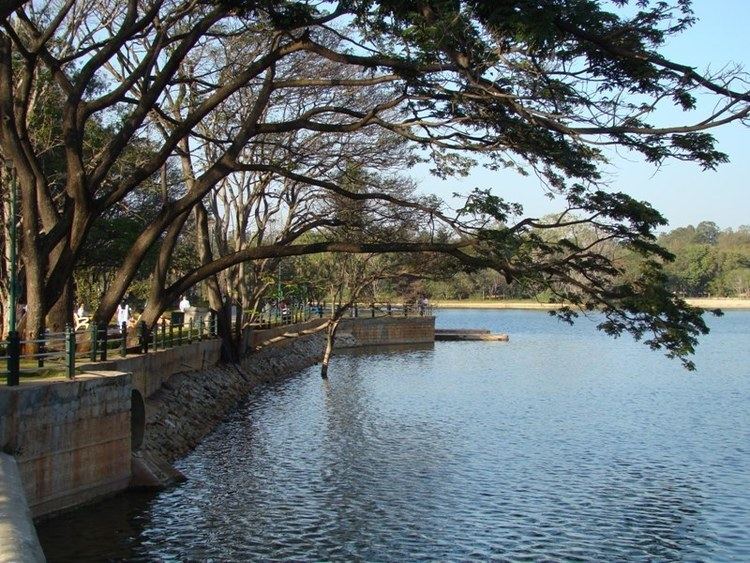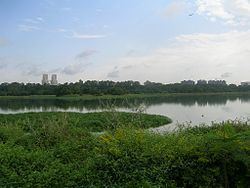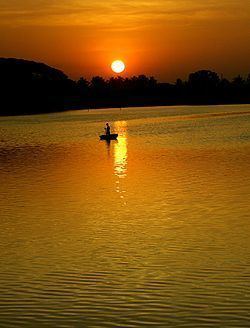Cities Bengaluru | ||
 | ||
Lakes in Bangalore, Karnataka are numerous, and there are no rivers close by. Most lakes in the Bangalore region were constructed in the sixteenth century by damming the natural valley systems by constructing bunds.
Contents
- History
- Encroachment of Lakes
- Topography and Hydrology
- List of lakes
- Flora and fauna
- Status of lakes
- Management
- Lake Development Authority
- Privatisation
- Impact of privatisation
- Protests
- LDAs contention
- Public interest litigation PIL
- Policy turnaround
- References
The effect of urbanization has taken some heavy toll on the Beautiful lakes in Bangalore. The lakes in the city have been largely encroached for urban infrastructure and as result, in the heart of the city only 17 good lakes exist as against 51 healthy lakes in 1985. Urban development has caused 16 lakes getting converted to bus stands, Golf courses, playgrounds and residential colonies, and few tanks were breached under the malaria eradication programme.
In recent years, the Management of Lakes traditionally done by the government agencies witnessed experimentation by the Lake Development Authority with a limited public–private sector participation in respect of three lakes, which has proved controversial and resulted in almost a reversal of the policy.

History
The earliest history of creation of lakes in and around the city is traced to the founders of Bangalore or Bengaluru –the Kempe Gowdas– in the Sixteenth century and later by the Wodeyars of Mysore Kingdom and the British.

Most of the lakes and tanks were man made for purposes of drinking water, irrigation and fishing needs and they have also favorably influenced microclimate of the city. The lake waters have also served as “Dhobhi Ghats” or places where washer–men (‘dhobis’ is the locale usage in India), have traditionally used them as a means of livelihood for washing clothes and drying them. The lakes have also served to replenish ground water resources in the vicinity, which are tapped through wells for drinking water.
In the 1960s the number of tanks and lakes was 280 and less than 80 in 1993. Until 1895 unfiltered water was supplied from tanks like Dharmambudhi (present day Bus station), Millers tank (Area opposite Cantonment railway station), Sankey and Ulsoor tanks. From 1896 water was supplied from Hessarghtta and from 1933 it was also obtained from Thippagondanahalli. In the 1970s the scheme to pump water from the Cauvery river 100 kilometres away was begun. The water needed to be raised up by 500 metres. The water demand in 2001 was 750 million litres per day and the actual supply is only 570 million litres per day and the per capita usage is about 105 litres per day. The national standard is 150 litres per day while the international standard is 200 litres per capita per day.
Encroachment of Lakes
Most of the lakes have vanished due to encroachment and construction activity for urban infrastructure expansion. The city once had 280-285 lakes of which 7 cannot be traced, 7 are reduced to small pools of water, 18 have been unauthorisedly encroached by slums and private parties, 14 have dried up and are leased out by the Government. 28 lakes have been used by the Bangalore Development Authority to distribute sites and build extensions for residential areas. The remaining lakes are in fairly advanced state of deterioration.
Some of the major lakes that disappeared over the years are:
Topography and Hydrology
The topographic setting of the city has radial slopes towards east and west with a smooth ridge running north to south; rainfall over the ridge area gets divided and flows east or west into the three gentle slopes and valleys of Koramangala–Challagatta, Hebbal and Vrishabavathi. Doddabettahalli 1,062 m (3,484.3 ft) is the highest point on this ridge. These naturally undulating terrain of hills and valleys, lends itself perfectly to the development of lakes that can capture and store rainwater. Small streams are formed by each valley starting with the ridge at the top. A series of shallow tanks varying in size are developed. The gentle topography has also good potential of ground water development.
Water resources are important for urban areas as they provide for a wide range of uses. Bangalore, with annual rainfall of 900 mm (3.0 ft) with three different rainy seasons covering nine months of the year. June to October is the rainy season accounting for 64% of the total annual rainfall in the S-W monsoon period and 324 mm (1.1 ft)during the N–E monsoons (November – December.). It has a salubrious climate with an annual mean temperature of 24 °C (75.2 °F) with extremes ranging from 37 °C (98.6 °F) to 15 °C (59.0 °F) . The streams between ridges and valleys have been dammed at suitable locations creating a cascade of reservoirs in each of the three valley systems. Each lake stores rain water from its catchments with excess flows spilling downstream into the next lake in the cascade. The storm water runs off through drains only. These drains often carry sewage in it, which results in the lakes getting polluted. Many lakes have reportedly springs at the bottom of the lakes, some of which are stated to be choked due to silt, which also feed the lakes.
The dependence on lakes, tanks, ponds, wells and other sources, in the past for supply of raw water to the city was de–linked with treated supplies arranged from river based schemes such as the "Chamarajendra Water Works" (Hesaraghatta Lake) built in 1894 and the "Chamarajasagar Reservoir" at T G Halli across the Arkavathy River in 1933 and subsequent sourcing from the Cauvery River schemes.
List of lakes
Of the several freshwater lakes and water tanks, the notable are the Madiwala Lake, the Hebbal Lake, the Ulsoor Lake and the Sankey Tank.
Notable lakes in Bangalore are:
Other lakes in Bangalore are Allalasandra, Attur Lake, BTM Lake, Chinnappannahalli, Doddanekundi, Kalkere, Kowdenhalli, Keravanhalli, Karithimmanhalli, Kaikondanahalli, Kengeri, Kodigenahalli, Mahadevpura, Uttarahalli, Doraikere, Dipanjali, Malgan,Veerasagara(Attur in Yelahanka), Veerasandra and Yelahanka.
Status of two of the centrally located lakes, namely, the Ulsoor Lake and the Sankey tank, which have been restored by the Forest Department of the State, are elaborated in the following sections.
Flora and fauna
The lakes in Bangalore are rich in flora and fauna (some species are pictured in the gallery) biodiversity.
Status of lakes
The lakes of the city have been largely encroached for urban infrastructure, and as result, in the heart of the city only 17 good lakes exist as against 51 healthy lakes in 1985. According to a scientific study carried out by the Centre for Ecological Sciences (CES), Indian Institute of Science, Bangalore, the water bodies of the city have reduced from 3.40 per cent (2,324 ha (5,742.7 acres)) in 1973 to just about 1.47 per cent (1,005 ha (2,483.4 acres)) in 2005 with built up area during the corresponding period increasing to 45.19 per cent (30,476 ha (75,307.8 acres)) from 27.30 per cent (18,650 ha (46,085.2 acres)). The adverse results of such large change are reported to be:
A recent study says most of the bangalore lakes are toxic with very less dissolved oxygen.
Management
Historically lakes in the Bangalore region were managed by a plethora of government agencies such as the Forest Department, Minor Irrigation Department, Horticulture Department, Public Works Department (PWD), Bangalore Mahanagara Palike (BMP), Bangalore Development Authority (BDA), Tourism Department, City Municipal Councils and Panchayats; each organisation claiming its own jurisdiction of ownership and maintenance rights resulting in a deficient, inconsistent and uncoordinated approach.
Expert Committees set up by the Karnataka Government, since 1986, highlighted the failure of the various bodies maintaining lakes in protecting them and also suggested that:.
A Public Interest Litigation was also filed in July 1985 citing the recommendations of the Expert Committee for implementation and the High Court duly directed the Government of Karnataka to take immediate steps for acting on the recommendations. The Government initiated action to establish a separate authority to address the problem of lakes and implement the recommendations of the Expert Committee and the Lake Development Authority was thus established in July 2002.
Lake Development Authority
The Government of Karnataka, following the directive of The Honourable High Court of Karnataka and considering the unchecked deterioration of lakes in and around Bangalore and keeping in line with their critical role in maintaining healthy environs and recharging of ground water, set up the Lake Development Authority (LDA) in July 2002 as a registered society under the Karnataka Societies Registration Act, 1959, as a non-profit organisation and a para–statal body with a mandate of
working solely for the regeneration and conservation of lakes in and around Bangalore city within BMRDA jurisdiction in the first instance, would be extended to other parts of Karnataka subsequently.
A Governing Council and other groups have been set up for the smooth functioning of the LDA. LDA’s jurisdiction has been extended, in July 2003, to cover other city corporations and town municipalities in the State. The Authority is high powered body headed by a Chairman who is the Chief Secretary, Government of Karnataka, Additional Chief Secretary, Government of Karnataka as Vice-Chairman, with a Chief Executive Officer, Lake Development Authority as Member Secretary with other members drawn from Planning, Science and Technology Department, Forest, Ecology and Environment Department, Finance Department, Information and Tourism Department, Urban Development Department, Minor Irrigation Department. Animal Husbandry and Fisheries Department all at the level of Principal Secretaries to the State Govt, Director, NRCD, as representative from MOEF, Government of India, The Secretary (Environment & Ecology), Department of Forest, Ecology and Environment, the Secretary to Government (Horticulture) Agriculture and Horticulture Department, Chairmen of Karnataka State Pollution Control Board and Bangalore Water Supply & Sewerage Board and Commissioners of Bangalore Mahanagara Palike and Bangalore Development Authority.
The defined charter of functions of the LDA is:.
The LDA initially identified 2,789 large, medium and small lakes within Bangalore Metropolitan Regional Development Authority (BMRDA) limits including 608 within the limits of Bangalore Development Authority (BDA) to take remedial and restoration measures. The Authority sought financial support from various funding agencies to implement identified activities. Several organisations and funding agencies have been involved in restoration of lakes in Bangalore and the activity has been coordinated by the Lake Development Authority. The details are:
Apart from the above lakes, LDA is coordinating lake restoration works, outside the Bangalore city, in other parts of the state with funding from the National Lake Conservation Programme (NLCP)
Privatisation
In 2004, the LDA began a process of "public-private participation" where private companies bid for the lakes to “develop and maintain” them for the next 15 years with the specified Terms of Reference. The tender specified the following Terms of Reference.
This was to be followed by beautification of lakes through:
The following lakes were leased out to private parties; the Hebbal Lake to E.I.H, the Nagavara Lake to Lumbini Gardens and the Venkanayakere to ParC Ltd out of which the first two were initially allotted. In May 2006, LDA leased out the Hebbal Lake, one of the largest lakes in Bangalore, to East India Hotels (the Oberoi group) for a period of 15 years for an annual lease amount of Rs. 72,10,000 (about US$1.44 million) and an annual escalation of 1.5% in the amount and an Investment of Rs.16,75,00,000 (about US$0.34 million) with a security deposit of 1.5% (Rs.25,12,500 – about US$0,50million) under the Public-Private Partnership policy. The Nagavara Lake was leased to Lumbini Gardens Pvt Ltd in April 2005 for a period of 15 years for an annual lease amount of Rs.4023,000 (about US $0.80 million) with an annual escalation of 1.5% of this amount every year for the 15–year lease period and with Investment of Rs.7,01,00,000 (about US$14.02 million) with a security deposit of 2% of this amount (Rs.14,20,000 – about US$0.284million).
As per the lease agreement, the above referred agencies were to carry out the development and maintenance of the lakes by:
Impact of privatisation
The social damage caused due to privatisation, as reported by a researcher, are:
Protests
The above private sector activities have resulted in major protests from citizen groups. Principal Chief Conservator of Forests has been urged by 500 residents requesting for abandoning the programme of handing over lakes to privatisation of lakes as they are developed as recreation focal points. Civil rights groups are in the fore front of these protests as they allege that the lake which is a common property resource is illegally fenced off and thus only privileged few could access it While the private developer contends that the lake will be a unique recreational place, the others feel that the entry fee of Rs 20 per person would exclude the traditional users (farmers, fishing communities, cattle herders, washer–men, and casual workers) of the lake. Environmentalists mention that the lake’s wetland ecology sustained scores of water birds but it will soon become only a pretty hygienic bowl. Environmentalists also say that four types of vegetation in the ecosystem grow at different water depths, sustaining about 30 species of birds. Birds such as sandpipers and clovers will find the lake too deep once the lake is deepened by removing the silt. Deep water birds such as ducks and cormorants will be disturbed by boating.
LDA’s contention
The Lake Development Authority contends that the organisation is not adequately staffed and that they do not have the finances for maintaining lakes on an ongoing basis. Hence, the alternative is leasing out lakes to private parties.
Public interest litigation (PIL)
A Public Interest Litigation (PIL) has been filed in 2008 by an Environmental Support Group (a Trust) and a public spirited individual of Bangalore in the High Court of Bangalore citing 16 respondents with the Lake Development Authority (LDA) as the second main respondent and the favoured respondents (at serial number 14,15 and 16) namely M/s Biota Natural Systems (I) Pvt. Ltd, M/s Lumbini Gardens Ltd., and M/s E. I. H. Limited, in respect of the ongoing privatisation of lakes/tanks in Bangalore. The PIL contends that:
PIL has sought redress from the Honorable High Court by way of issue of writ or order in the nature of Mandamus repealing the ‘Lease Deeds’ executed by Respondent (the LDA) in favour of the beneficiary respondents (to whom the lakes were leased – Respondents 14, 15 and 16) and requested the Court to direct the Government of Karnataka (as first Respondent) to ensure full compliance with the law and policies relating to protection and conservation of lakes/tanks/wetlands.
Policy turnaround
With the privatisation approach for development and management of lakes not proving to be popular, and considering the serious protests by the public and the pending Public Interest Litigation (PIL) in the High Court of Karnataka seeking redress, the Government of Karnataka has now decided to make amends with a paradigm shift in its approach by declaring that the State Government would undertake, through its agencies such as the Bangalore Development Authority (BDA), BBMP and Bangalore Metropolitan Region Development Authority (BMRDA), the rejuvenation works of 27 lakes in the Phase I by allocating finances to the extent of Rs 1.5–2 crores (US$375,000 to 500,000) per lake which would involve:
The LDA has transferred 17 lakes to BBMP while rest of the lakes are now controlled by Karnataka Forest Department.
